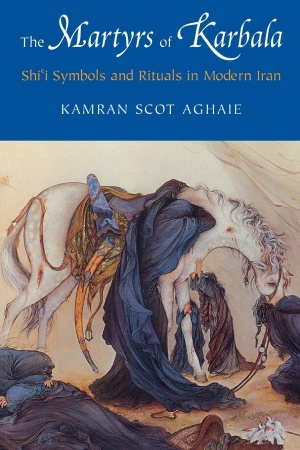The martyrs of Karbala : Shi'i symbols and rituals in modern Iran
The book The Martyrs of Karbala: Shi'i Symbols and Rituals in Modern Iran explores the ebb and flow of religious fervor in Iran for over two centuries.
 | |
| Author | Kamran Scot Aghaie |
|---|---|
| Language | English |
| Genre | Historic |
| Published | 2004 |
| Publisher | University of Washington Press |
| Pages | 216 |
About the authorEdit
Kamran Scot Aghaie (born December 8, 1967) is associate professor of Islamic and Iranian History at the University of Texas at Austin, and has served as director of the Center for Middle Eastern Studies and chair of the Middle Eastern Studies Department. His primary research interests are Islamic studies, Shi'ism, modern Iranian and Middle Eastern history. He is also interested in world history, historiography, religious studies, nationalism, gender studies and economic history.
About the bookEdit
This book in 216 pages was among best seller books of 2004 and about 2،566،290 copies of it have been sold. The book contains 9 chapters:
- A Brief Historical Background of Shiʿism and Muharram (pp. 3-14)
- The Qajar Elites and Religious Patronage (1796–1925) (pp. 15-29)
- Qajar Society and Religious Culture: Tehran as a Case Study (pp. 30-46)
- The Pahlavi Regime and the Emergence of Secular Modernism (1925–1979) (pp. 47-66)
- Religious Rituals, Society, and Politics during the Pahlavi Period (pp. 67-86)
- Huseyn, “The Prince of Martyrs” (pp. 87-112)
- Fatemeh, Zaynab, and Emerging Discourses on Gender (pp. 113-130)
- The Islamic Republic (pp. 131-153)
- Conclusion (pp. 154-162)
Abstract of chaptersEdit
In the first chapter, the author gives information about how Islam divided into two sects, Shiite and Sunni. He follows this section by talking about the rivalry between Shiite and Sunni and its culmination, the Karbala incident, and in this regard explains rituals and mourning ceremonies.
In the second chapter the author discusses the ways through which Qajar support for mourning rituals came to being and developed over time, and what were its consequences for the wider politics of the era. The cooperation between the monarchy and religion reflects many things about Qajar society and culture during the 19th and early 20th centuries.
In the third chapter the distribution of mourning rituals in Tehran, its expansion and the prevalence of that among rich and poor people are illustrated. These cases were not completely under the control of the government until Pahlavi came to power and tried to take control of the rituals, in this regard, Iran experienced economic and political changes.
In the fourth chapter, the author argues that Pahlavi was strongly dependent on the West, Western (modern) cultures replaced Iranian (traditional) culture, and the Shah's opposition to Shiism began.
Chapter 5 shows that the content of the mourning speeches was changed and the discussion of politics were included in them. On the other word, popular opposition as protest against the government, lead to an incident such as the Faizieh school incident.
In chapter 6, the author tries to portray the event of Karbala and how to speak about it in mourning from a political and social point of view.
Chapter 7 discusses about the prominent role of women in Islam and the fact that they were responsible for much of the descriptions and Battle of Karbala incident in the social, cultural and religious environment of Iran.
Chapter 8 of this book shows how the Islamic state was formed against the ruling regime in Iran by Khomeini using the Karbala paradigm.
In the last chapter, the author refers to Iran's progress and inability of government for controlling the situation. By the passage of the time, Karbala mourning ceremonies change. At the end, this book is highly recommended to all those interested in modern Shiite and Iranian history, who wants to know how cultural, social, and political history of the Muharram rituals and symbols are interrelated.